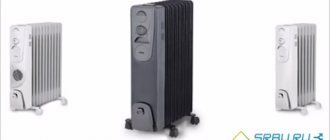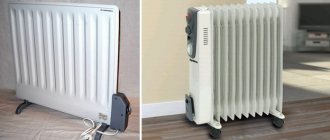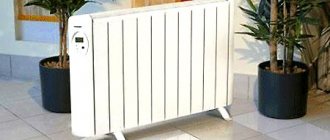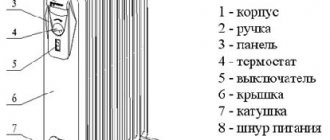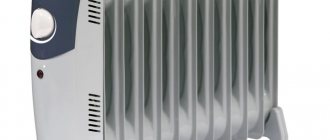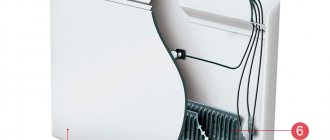SHARE ON SOCIAL NETWORKS
FacebookTwitterOkGoogle+PinterestVk
Central heating is not always enough to provide a comfortable atmosphere in the house. Therefore, it is often necessary to use additional heating devices. The most popular of them are a convector or an oil heater: which is better can be decided by familiarizing yourself with the advantages and disadvantages of these devices, as well as the features of their use.
Heaters can be either the main or additional source of heat
Operating principle, pros and cons of an oil heater
When choosing an oil heater for your home, you should understand the principle of its operation. Externally, it is a metal case, inside of which there is a container with mineral oil. After turning on the device, the heating element starts working, which increases the temperature of the oil. The oil, in turn, heats the metal body, and it gives off its heat to the environment. This takes quite a long time, but the heat spreads evenly throughout the room.
An oil heater heats the room slowly but evenly
The intensity of air heating in such radiators is usually adjustable, and the design is equipped with wheels for greater mobility. There are floor and wall oil heaters. It is advisable to buy the latter if there is a small child or pets in the house. This heating device operates intermittently. When the room temperature rises to the desired level, the built-in sensor turns off the heating element. When the temperature decreases, the reverse process occurs. Thus, using an electric oil heating radiator saves energy.
The advantages of an oil cooler include the following:
- High level of safety - all heating elements are hidden inside the housing, so you don’t have to worry about getting burned on the oil heater. In addition, most models are equipped with a special sensor that turns off the device when it tips over.
- No noise during operation - you can safely install a household electric oil heater in a bedroom or office. Also, the device takes up little space, and it can be placed not only on the floor, but also on the wall.
- Long service life - the heating element of the oil radiator is reliable and durable, and the device itself can work for several days without interruption. Most modern models are equipped with built-in overheating protection.
- There is no unpleasant odor during operation. In addition, modern oil heaters (Delonghi and other companies) do not dry out the air in the room, so you do not have to buy an air humidifier with the device.
- The price of the heater is quite low, so everyone can afford it.
Oil radiators have many advantages, such as quietness, efficiency and safety.
Like any household appliance, an oil heater has its drawbacks. Among them are:
- The air in the room takes a long time to warm up, especially if we are talking about a large room. This problem can be corrected if you buy an oil heater with a fan: the heated air will spread faster.
- The design itself weighs quite a lot, so it is better if the device is equipped with wheels. An oil heater should only be hung on the wall if it has reliable fastenings.
Helpful advice! When choosing an oil heater, pay attention to the manufacturer. As a rule, brand recognition guarantees the high quality of the heating device.
Price
| Name | View | Power , W) | Control | Moisture protection | Heating area (m²) | Price, rub.) |
| "Resanta" OMM-7N | oil radiator | 700 | mechanical | No | up to 7 | 1810 |
| Zanussi Espressione ZON\ES-07W | oil radiator | 1500 | mechanical | No | up to 15 | 3370 |
| Polaris PRE M 0715 | oil radiator | 1500 | mechanical | No | up to 15 | 2790 |
| Ballu BEC\ESER-1500 | convector | 1500 | electronic | There is | up to 20 | 2498 |
| Electrolux ECH\AG-1500 EFR | convector | 1500 | electronic | There is | up to 20 | 2950 |
| Timberk TEC.E0M 1500 | convector | 1500 | mechanical | No | up to 20 | 1674 |
Each specific heater model has a number of positive properties and negative features. Guided by the article, you can make a choice in favor of the climate control system you like.
Types of oil heaters: wall-mounted and floor-mounted
Different models of heating devices may differ in power, size, appearance and other characteristics. For example, depending on the location features, oil heaters are distinguished such as:
- wall;
- floor;
- desktop
Oil heaters can be of different sizes and types of placement
Using a wall-mounted model saves space, but also increases the time required to warm up the air in the room. The fact is that heated air rises, so the lower the heating device is located, the more efficiently it works. Because of this, oil heaters are often installed under windows.
Floor-standing options offer the greatest mobility. They can be easily moved from room to room and put away when not in use. The circuit diagrams of floor- and wall-mounted oil heaters are practically the same.
In addition, such heating devices can have a large number of additional functions and capabilities. These include, for example, a fan that disperses warm air throughout the room, a humidifier that allows you to create a comfortable level of humidity in the room. And the best oil heaters are equipped with temperature sensors and can be programmed to turn on and off at specific times.
High-quality oil heaters are equipped with temperature sensors, which helps save energy
Which is safer?
If the oil cooler is not equipped with a casing, the high temperature resonance of the battery can cause burns. The same cannot be said about a convector, whose relatively low thermal performance cannot cause harm.
The environmental friendliness of household heaters takes pride of place: due to the absence of open combustion processes in them, both devices eliminate the possibility of them burning oxygen in the room. In addition, the convectors are equipped with an additional filtration system:
- Antistatic dust filter.
- Carbon filter – absorbs foreign odors.
- Catechin filter – kills microbes, destroys viruses, absorbs unpleasant odors.
- Nano Silver filter – ionizes the air, fights germs.
Calculation of the power of an oil heater with and without a fan
The main criterion when choosing any heating device is its power. Therefore, before purchasing, it is worth measuring all the necessary parameters so as not to overpay, but also not to purchase an insufficiently powerful device. If your apartment has standard ceilings with a height of 2.75 m, then for heating every 10 m². you will need 1 kW of device power. For different ceiling heights, the heater power is calculated as follows:
- The length and width of the room are measured and its area is calculated.
- The resulting value is multiplied by the height of the ceilings to obtain its volume.
- The volume is divided by 25, since 25 m³ requires 1 kW of energy.
The resulting figure will be the required power for your oil heater. The presence of a fan in the design affects only the rate of heating of the room, but not the required power.
DIY oil heater
If you want to save money, you can make an oil-type heating device yourself. To assemble an oil heater with your own hands, you only need a metal case. Heating element and oil. The answer to the question of which oil to use in oil heaters is purified and heat-resistant.
Design diagram of an oil-filled heater
This is necessary so that scale does not form on the walls of the heating element, and the oil itself does not boil at high temperatures. If you need to know more precisely which oil can and cannot be poured into oil heaters, then you should turn to professionals.
Helpful advice! You can use a regular cast iron battery as a housing for a homemade heating device. The material has good thermal conductivity, and inside such a housing you can easily install not only heating elements, but also a lot of other useful improvements.
The electrical diagram of an oil heater for self-assembly can be easily found on the Internet, and for greater efficiency you need to choose the right heating element. It should be powerful enough, but without a magnesium anode, as this can cause the heating element to quickly fail. Also, during assembly, it is necessary to understand the oil circulation pattern in the device.
To repair an oil heater with your own hands, you also need to understand the principle of operation of the device and the internal structure of the structure, as well as have special tools and skills, otherwise the repair may lead to more serious damage. If you are not confident in your abilities, then it is better to entrust this task to experienced specialists.
Electrical circuit of the oil cooler
Design and principle of operation of convector heaters
In terms of simplicity of design, a convector heater is not inferior to an oil heater. It also has a heating element that raises the air temperature. The name of the device itself comes from the principle of convection, when warm air rises and cold air falls down. It is thanks to this air circulation that the room is heated.
To the question of how convectors differ from oil heaters, the answer is very simple - in the first type, the heating element heats the air directly, and not the body of the device. This provides a number of advantages, for example, the body of the device does not heat up as much. According to the type of energy consumed, electric, gas and water convectors are distinguished, each of which has its own characteristics, but in design and power they are not very different from each other. The most common are electric convector heaters.
There are also infrared convectors that use infrared radiation to heat the air. As a rule, the efficiency of such models is low, so it is best to use combined convective-infrared heaters. They will be able to quickly and evenly heat the air even in a large room.
Convector heaters heat the room by circulating air
Operating principle of the convector
The principle of operation of a convector heater, regardless of the type of thermal energy source, is to use the quality of the gaseous medium to rise during heating, then cool down and fall.
An integrated heating element moves air through the unit from bottom to top. The heated air tends upward, giving off heat to the surrounding space of the room, then cools down and goes down.
Heat exchange is enhanced by the upward movement of heated air along a parabola. The air space in the room where the convector heater operates heats up to an acceptable temperature in 15-20 minutes.
Convectors are gas, electric, water. Gas ones are economical, but unsafe. Electric ones are easy to install, safe, but consume a lot of energy. Water ones are more difficult to install, but they are optimal from an economic point of view.
Types of convectors
- With electronic thermostat. They are silent. Disadvantages - price, failure due to power surges.
- With electromechanical thermostat. Immune to power surges. The disadvantage is a large error in measurements.
- Floor-standing. Mobile, you can easily move around the room.
- Wall-mounted. They have a small thickness and can be vertical or horizontal. Installed under windows. Due to their attractive appearance, they can be placed on walls.
- Ceiling. Mounted on the ceiling, often installed in dachas or country houses.
- Built-in. They are often mounted in floor niches and then covered with gratings.
Pros and cons of convector heaters
Unlike a floor or wall-mounted electric oil heater, a convector does not heat the body, but immediately begins to warm up the air. This means that when using such a device, the room temperature rises much faster than when using an oil radiator. At the same power, an oil heater can warm up a large room for up to an hour, while a convection heater can handle it in a significantly shorter period of time.
Another advantage is that the body of a water, electric or gas convector heater practically does not heat up during operation, which eliminates the possibility of burns or damage to property. Using such a heating device is completely safe, even if there are small children in the house. The housing itself can be made of various materials with different levels of thermal conductivity.
Separately, it is worth noting the safety systems of convector heaters. Almost every model has regulation of energy consumption and temperature, which can be done using an electronic or electromechanical thermostat. Also, many models have protection against high humidity, that is, they can be used not only in living rooms, but also in bathrooms and other rooms with high humidity levels.
Convector-type heaters are characterized by the speed of heating the room, high safety and efficiency
This heating device has few disadvantages:
- Uneven heating of air at different heights - when using a convector, the difference in air temperature near the floor and near the ceiling can be up to 9-10°C, since the heated air immediately rushes upward, while the cold air remains below.
- Dust also circulates along with the air, so it is not recommended to use the device in dusty rooms.
- It is possible to install convectors on the wall or near the ceiling, but this makes little sense, since in such cases the temperature difference at different heights will be even greater.
Helpful advice! The use of an infrared convection heater can somewhat reduce these disadvantages, but such models are characterized by lower operating power.
Wall-mounted infrared convector heater
Additional functions
Convectors:
- Electronic control, display, remote control. These “bells and whistles” allow you to more accurately set the required temperature and control the device without leaving the couch. Radiators with a mechanical thermostat cannot boast of such accuracy.
- Operating modes. Most convectors are equipped with preset modes that allow, for example, saving energy (“economy” mode).
Oil radiators:
- Drying things. Additional slats where you can hang and dry things are the strongest advantage of the radiator. This trick will not work with convectors.
General features:
- Built-in ionizer. There is still debate about the benefits of air ionization, however, many models have this option.
- Frost protection. A function that allows you to maintain a low positive temperature in the room for a long time if the owners are absent for a long time.
- Humidifier. A useful option especially for dry climates. Moreover, the humidifier works autonomously and can always be turned off if the room is very damp.
- Timer. Allows you to preset the time by which the device will warm up the room.
Prices of oil electric heaters and convectors
The price category of a heating device depends on its power, manufacturer, availability of additional functions and other characteristics. The price of a low-power oil household electric heater will be about 2,500 rubles. The cost of more powerful models is in the range of 3-4 thousand rubles. The price of the device is affected by the heating area and the number of sections.
When choosing a convector, you must also pay attention to the power and manufacturer. Here the price can vary from 1500 to 4500 rubles. Infrared models are cheaper; you can purchase such a heater for 1000 rubles or less.
If you want to buy a Delonghi oil heater, then be prepared for serious expenses, since products from a famous brand are more expensive. If you don’t want to overpay for a brand, then you can turn your attention to heating devices from lesser-known companies.
Comparison of characteristics
To buy a really cool heater, you need to compare its technical and operational characteristics with alternative offers. In our case, we will compare the oil tank and the convector according to the following criteria:
- cost is the most important indicator. The incomes of most Russians are such that they first of all pay attention to the difference in price;
- durability is an important indicator, but often ignored due to the low cost of the device you like. After all, a heater is needed here and now, but there is no money for an expensive but durable purchase;
- coefficient of performance (efficiency) - according to an established tradition, consumers are always looking for information on how efficiently heating devices use electricity. Nobody wants to overpay for its consumption. Manufacturers also support this interest, describing how economically their product works;
- room heating rate. The criterion for a residential building and apartment is of little significance: it has basic heating. But for a dacha or garage - the most important;
- ease of use. When buying any electrical appliance, you always want one thing: plug it in and forget about its existence;
- design - there is only one desire: for the newly acquired item to fit well into the interior. Therefore, consumers sometimes spend a long time selecting a heater based on design, ignoring other characteristics or relegating them to the background;
- safety. No less important indicator. Particular attention should be paid to it with small children in the family;
- availability of additional functions. Little attention is paid to this criterion, but in vain.
Which is cheaper?
The range of prices for “oil tank” and convector is enormous. For example, an oil radiator with a power of 0.5 kW can be purchased for 1,699 rubles. And next to it is three times more powerful for almost the same price - 1990 rubles. The same situation applies to convectors. But in general, oil pans are about 30-40% cheaper.
Conclusion: you will have to pay a lot of money for a convector.
What will last longer
The best indication of actual service life is the warranty period. After all, they are always 2-3 times less than the actual operating time. Let's compare:
- oil battery - warranty period 1-2 years, actual service life from 5 to 7 years. True, there are also long-livers: with several replacements, the heating element lasts more than 15 years and does not go to landfill;
- convector - warranty period is 5-10 years, actual service life is 15-20 years.
Conclusion: in terms of durability, the convector is the leader by a wide margin - there is simply nothing to break, and a burnt-out heating element can be replaced.
What is more effective
There is a myth circulating among sellers and specialists that the convector is economical. Its electricity consumption is approximately 25% lower. If you carefully read school textbooks on physics, you will find out, and scientific publications confirm, that for all heating elements, without exception, the efficiency of electricity use is in the region of 98-99% (losses are attributed to the resistance of indoor wiring). Our devices are no exception.
To be fair, we note that the myth was not born out of nowhere: prolonged heating of the oil and housing was considered a loss of electricity. But they did not take into account that after switching off, the accumulated heat is given back for a long time, while the convector cools down almost immediately.
But there are other factors when assessing effectiveness that are not considered at all. One of them concerns the installation location of the heater: the higher it is, the lower the output: the ceiling is heated. And this directly applies to convectors: most of the models are wall-mounted. The second has to do with the height of the room. With a ceiling higher than 3 m, the oil pan will heat in standard mode; there is practically no benefit from the convector: a well-heated “dead zone” is formed at the top, which is not captured by convection currents.
Conclusion: an oil heater is still more efficient.
Which heats up faster?
The convector begins releasing heat to the air masses in the room almost immediately after switching on. Therefore, it heats the room faster. The oil radiator and built-in fan heater do not help. The warming up process increases sharply, but is still slightly inferior in time to its competitor due to prolonged heating.
Conclusion: according to the analyzed indicator, the convector is the best.
Which is more convenient to use?
If you have electronics, connect the oiler to the power supply, set it up and enjoy. A little different with convectors. There are two problems here:
- the rise of a huge amount of dust into the air, which likes to settle in places hard to reach for cleaning - you have to wipe shelves, chandeliers, lamps, etc. more often;
- crackling of the tubular heating element. You quickly get used to it, but it’s still unpleasant.
The oil-based device does not have problems with dust due to weak air flows.
Conclusion: the oil battery does not create problems during operation. She has the advantage.
The result of the convector operation.
Design
It has been rightly noted that “there is no comrade according to taste.” Therefore, we will not evaluate the design of the devices being compared - everyone has their own tastes and preferences. Let us refer to reviews left by consumers on various forums, where an interesting situation has arisen.
By all accounts, free-standing oil heaters have an advantage over convectors - they look much nicer. But it’s difficult or impossible to fit the handsome guy into the design of the rooms - they look like a foreign body.
The design is good, but how to fit such a device into the interior.
Conclusion: It is difficult to judge whether a convection heater or an oil radiator has a better design. Still, we’ll give a slight advantage to the flat convector - it looks more harmonious in the apartment, especially on the wall.
Safety
Both devices are almost equally “stuffed” with security systems. There is a shaky but parity here. However, there are a few things.
- When oil reaches a certain temperature, it does not boil, but ignites, even in hermetically sealed containers. The result is an explosion and fire. Therefore, it is extremely important not to dry any items directly on the oil device, preventing the sections from overheating. For such purposes, there are various shelves that are hung on the battery case.
- The convector body temperature does not exceed +60oC. The situation is approximately the same with competitor models with a protective casing. If it is not there, then the risk of getting burned tends to 100% - the body sometimes heats up to +100oC;
- Convectors with tubular and solid heating elements can be installed in the bathroom without fear. There are no oil devices. The reason is the risk of microcracks forming on the body when water enters. The welding seam is especially dangerous.
- A working oil pan should not be left unattended for long periods of time. The leaking oil from the formed microcracks burns beautifully, as more than a dozen families have been convinced of.
Conclusion: despite almost identical safety systems, the convector has a rather significant advantage.
Additional functions
In both heaters you can find additional features:
- electronic control;
- different operating modes;
- built-in ionizer;
- humidifier.
All this is good. But the “oiler” has something that the convector does not have - quick drying of clothes and shoes. The convector also has similar attachments, but it dries much slower - the body temperature is lower.
It is believed that it is impossible to dry things on a convector. The photo refutes this point of view.
Conclusion: in situations where you need to quickly dry things, an oil radiator is in the lead.
Which heaters are better: oil or convector
To fully understand what is better, convector or oil heaters, you need to compare their main characteristics:
- time for heating the air in the room. In an oil radiator, the heating element is first heated, then it heats the oil, which transfers heat to the body, which already begins to heat the air. In a convector, the air is heated immediately. It is worth understanding that if you are going to buy an electric oil heater with a fan, then it will heat the air at the same speed as a convector, or even faster. This is due to the relatively low power of the convector heater;
When choosing a device, pay attention to such an important characteristic as power
- electricity consumption. In this regard, the convector is about a quarter more economical than an oil radiator of the same power. This factor may turn out to be decisive, since the significant energy consumption of an oil-based device can cost a pretty penny;
- ease of installation and operation. Convectors weigh several times less than bulky oil-based appliances, which is why moving them from place to place is much more convenient. They are also easier to mount on a wall, although this does reduce efficiency. Modern models of both types of devices are equipped with sensors, simple and clear controls and displays, so the level of ease of use is approximately the same and largely depends on the manufacturer and model;
- safety of use. The answer to the question of which oil heaters are better may well be those that heat up less during operation. Hot oil noticeably heats up the housing, but convectors are completely safe in this regard. You can easily leave such a device turned on unattended, while doing this with oil-based ones is highly not recommended;
Compared to oil heaters, convector heaters are safer
- environmental friendliness and health safety. Oil or convector heaters do not have parts in their design that could burn oxygen, so in this regard, both types are completely safe. When a convector is operating, dust can circulate in the room, which does not happen when an oil heater is operating. But here a lot depends on the cleanliness of the room;
- durability. Convector heaters last significantly longer than oil heaters, and they are much easier to repair. One of the most common causes of oil cooler failure can be the occurrence of microcracks through which oil leaks and evaporates. Repair in such cases is very difficult or simply impossible;
- price. Oil radiators are cheaper than convectors of the same power, but in terms of overall performance characteristics they are significantly inferior to them, so the savings can be very doubtful.
In addition to the characteristics already listed, it is worth noting that the improvement of convector heating devices is happening much faster than oil ones, which are slowly but surely disappearing from the market. The latest invention in this regard is the monolithic heating element of the convector, which doubles the thermal power of the device with the same electricity consumption.
The device of a modern convector heater
In addition, when choosing a convector or oil heater, you need to take into account the degree of protection, and in terms of this characteristic the latter clearly loses. It is a rare convector that is not equipped with protection against overheating, voltage surges and tipping over. While oil radiators are often found without protection at all.
How are they different from each other?
Unlike convectors or oil heaters, infrared heaters are able to almost immediately create the desired temperature in the room. There is no need to wait for the air masses to mix. You just need to provide access to infrared radiation to the object - the heat will be felt immediately. However, it cannot be felt throughout the entire room, since local heating of a specific point occurs.
Fan heaters and oil heaters are mobile, unlike other types of heating devices and are cheaper.
Convector or oil heater: which is better to buy for home and office
Taking into account all the characteristics considered, we can say that convector-type heating devices have more advantages than oil ones. But this does not mean that the latter have completely lost their positions and are not used anywhere. Radiators with oil as a coolant are cheaper than other types of heating devices, which still makes them very popular. Also, an oil radiator can be effectively used where rapid air heating is not needed, but its uniformity is appreciated. And models with a built-in fan can warm up the room even faster than a convector.
When choosing a heating device model for your apartment or office, take into account the totality of its characteristics, the manufacturer’s reputation and other factors. A good oil radiator will be more efficient than a poor quality convector. Reviews also play an important role when choosing. Which is better, oil heaters or convectors of one type or another can be found out from the reactions of users on the Internet.
What is better to choose and in what case
The advantages of a convector are obvious, but the oil pan is better suited for the office. It is also purchased when there is a limited budget or the need for uniform heating. You can’t do without it in the garage either—extra dust doesn’t belong there. The device also fits well into the heating system of an apartment or house if additional heating is needed while the main heating is constantly running.
In other cases, a convector is preferable, especially at the dacha, where quick heating of the room is needed. Recommendations are not the ultimate truth - the choice in any case falls on the shoulders of the consumer.

